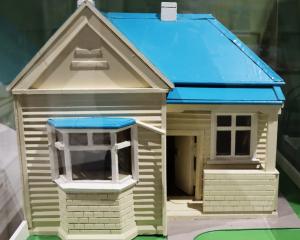It's time to mix it up in the second part of our training schedule for the Dunedin half-marathon, writes Gary Dawkins,of Creative Conditioning at River Ridge Retreat.
Five weeks into our training for the Cadbury Dunedin half-marathon we have covered some significant territory.
It is time to begin building on that, not just by stretching the time involved and the distance covered, but by adding some extra elements.
The second part of our three-part training programme, for both the 21.5km run and the 21.5km recreational walk, is the ''progressive phase''.
It includes stretches, resistance and core exercises to incorporate into your training programme.
The third and final part of the programme is the ''overload'' phase. It will also include the optimal nutrition to follow for the remaining weeks leading up to the half-marathon.
You can see at the first part of the training programme at www.odt.co.nz.
Before starting a training programme for the first time for the half-marathon it is important that you consult your doctor.
Jogging (runners only): You should be at an intensity level where you can comfortably hold a conversation.
Short to moderate runs (runners only): You should be in control of your breathing and be able to just hold a conversation.
Long runs (runners only): Once a week there is a long run that will increase in distance each week. Plan to complete it when you have more time.
Long walks (walkers only): We will do these on the days you have most time. They condition us to actually finish the 21.5km.
Walking and power walking (walkers only): In this phase of our programme we progress to power walking on certain training days (power walking is when you are at an effort level of 9/10 - much faster than this and you would be jogging).
Rest days: These days are as just as important as our training days. Fitness improvements can only occur when our body has sufficient rest periods.
Cross-training: Continuous compressive loading on our joints can cause long-term injury. It is very important to do the cross-training days in the programme so your joints get the recovery they need. It is fine to walk for a while when you are feeling tired on the runs, as walking is a type of cross-training.
Stretching: This is important, especially after the long run. The quadriceps, hamstrings, calves, hip flexors and arms need to be stretched to help reduce muscle soreness.
Resistance training: Running puts a lot of pressure on our hip, knee and ankle joints. We will be using body-weight strength exercises to enable the muscles to support these joints. Our strength exercises will also help to iron out any biomechanical imbalances that can cause major problems when running is intensified.
Changing the plan: Yes, you can substitute one day with another if it suits. Just as long as you complete all of the required exercise each week. Training plans only work if they are flexible.
Where do I run or walk? Choose places you enjoy. At the beach, beside the harbour or on off-road tracks. Ross Creek in Dunedin has lots of bush tracks, the Millennium track between Taieri Mouth and Henley follows the Taieri River and there is the track beside Otago Harbour to St Leonards, just to name a few. Keep in mind that you will need to get used to running on tarseal for the marathon course. Make sure at least two of the weekly runs are on tarseal.
Hydration: Drink plenty of water before each training session. Modify the quantity depending upon the temperature and the distance you will be running.
Nutrition: Follow a well-balanced food plan. It should consist of 60-70% carbohydrates, 20-30% protein and 10-15% fat. Before going on longer runs (about two hours before) eat a more complex carbohydrate meal such as pasta. After your longer runs, rehydrate with water and eat a mixture of carbohydrates and protein.
Timetable: This programme is designed to start on Monday, June 24. That allows for 11 weeks until Sunday, September 8, which is event day. The programme is designed to help runners and walkers complete the half-marathon run or walk, not race it.
The effort level in the programme is represented on a scale of 0 to 10, where 0 is standing still and 10 is running (or walking, if you are completing the half-marathon walk) at an effort level that is as fast as you can go and still last the required duration.
The 2013 Dunedin Cadbury Marathon
- The Dunedin Cadbury Marathon is on Sunday, September 8, and comprises three events.
- The full marathon is a 42.5km running event for people 18 years and older. The race begins by the royal albatross colony at Taiaroa Head and follows Otago Peninsula into town then loops back to finish at Port Chalmers. All competitors have a time limit of five hours to complete the race.
- The half-marathon run is a 21.5km event open to all runners. All participants 16 years and younger must have written consent from a parent/guardian. The race begins in the carpark outside the east stand of Forsyth Barr Stadium. The course first passes through the university area and Dunedin Botanic Garden, before making its way to Port Chalmers, finishing at Watson Park.
- The recreational half-marathon walk is a 21.5km event that requires a reasonable level of fitness to complete. No running is allowed, so if you intend running some of the event then you must enter as a runner. This event also starts at the carpark outside the east stand of Forsyth Barr Stadium and follows the same track as the half-marathon run, finishing at Port Chalmers.
Entry forms for the three events can be obtained by visiting www.dunedinmarathon.co.nz
Cross-training programme
Wall squat: Complete three sets of holding this position for 20-60 seconds (really challenge yourself here) and rest for 20-60 seconds between each set.
Press-ups (either kneeling press-ups or full press-ups): complete three sets of eight-20 repetitions and rest for 30-50 seconds between each set.
Prone abdominal hold: Three sets of holding each set for 20-60 seconds (really challenge yourself here) and rest for 20-60 seconds between each set.
Lying abdominal leg cycles: Complete three sets of 16-30 cycles, where each leg cycle is counted as one repetition, and rest for 20-50 seconds between each set.
Seated hamstring stretch: Complete two sets on each leg and hold each stretch for 20-25 seconds.
Calf stretch: Two sets on each leg and hold each stretch for 20-25 seconds.
Quadricep and hip flexor stretch: Two sets on each leg and hold each stretch for 20-25 seconds.
Hip rotator stretch: Two sets on each leg and hold each stretch for 20-25 seconds.














